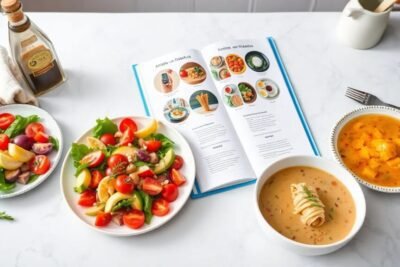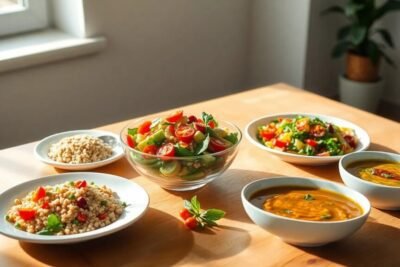
Discover Diabetes-Friendly Foods: Your Essential Guide
- Understanding Diabetes and Its Dietary Needs
- What Makes a Food Diabetes-Friendly?
- Top 10 Diabetes-Friendly Foods You Should Include in Your Diet
- How to Create Balanced Meals with Diabetes-Friendly Foods
- Healthy Snacks for Diabetes Management
- Meal Planning Tips for a Diabetes-Friendly Diet
- Hydration and Its Importance in Diabetes Management
- Managing Cravings: Tips and Tricks
- Download Your Free Diabetes-Friendly Foods PDF Guide
Understanding Diabetes and Its Dietary Needs
Diabetes is a chronic metabolic condition characterized by elevated levels of glucose in the bloodstream, resulting from the body’s inability to produce or effectively use insulin. Insulin is a hormone produced by the pancreas that facilitates the entry of glucose into cells for energy. There are primarily two types of diabetes: Type 1, which typically develops in childhood and involves an autoimmune destruction of insulin-producing cells, and Type 2, which often emerges in adulthood and is frequently associated with lifestyle factors. The management of diabetes involves not only medical intervention but also significant dietary control.
A well-structured diet plays a crucial role in diabetes management, as it directly influences blood sugar levels. Individuals with diabetes must prioritize foods that stabilize their glucose levels while providing essential nutrients. The categorization of foods into diabetes-friendly options means they are lower in refined carbohydrates and sugars and higher in fiber, healthy fats, and proteins. Following a diabetes-friendly diet is fundamental; it minimizes the risk of complications such as neuropathy, cardiovascular disease, and kidney problems.
Food choices can significantly determine an individual's overall well-being. High glycemic index foods, such as white bread and sugary snacks, can lead to sharp spikes in blood sugar levels, while low glycemic options like whole grains, legumes, and non-starchy vegetables promote a steady release of glucose into the bloodstream. An accessible way to find beneficial options is through resources like a diabetes-friendly foods PDF, which can serve as a practical guide for making informed dietary choices. Understanding the balance and nutritional content of meals is imperative for anyone living with diabetes, as this knowledge empowers individuals to maintain better control over their condition.
What Makes a Food Diabetes-Friendly?
Identifying diabetes-friendly foods is essential for managing blood sugar levels and overall health. Such foods generally possess several key characteristics that contribute to their suitability for individuals with diabetes. One of the primary traits is a low glycemic index (GI). Foods with a low GI release glucose slowly into the bloodstream, preventing spikes in blood sugar levels. This is critical for maintaining stable energy and preventing complications associated with diabetes.
In addition to the glycemic index, high fiber content is another important aspect of diabetes-friendly foods. Fiber aids in digestion and can help regulate blood glucose levels by slowing the absorption of sugar. Foods rich in fiber, such as whole grains, fruits, vegetables, and legumes, not only improve overall health but also provide a feeling of fullness, which can help with weight management.
Incorporating lean proteins into one's diet is equally vital. Proteins play a role in preserving muscle mass and providing a source of energy without causing significant blood sugar fluctuations. Options like chicken, turkey, fish, and plant-based proteins such as lentils and beans are excellent choices. Healthy fats, including sources such as avocados, nuts, and olive oil, also contribute to a diabetes-friendly diet. These fats can enhance satiety and improve heart health, both of which are crucial for overall wellness.
When evaluating food options, it is beneficial to consider the balance of macronutrients. A diet that integrates low glycemic index foods, high fiber content, lean proteins, and healthy fats can significantly aid in managing diabetes. By familiarizing oneself with the characteristics of diabetes-friendly foods, individuals can make informed dietary choices that support their health needs. For additional details and resources, a diabetes-friendly foods PDF can serve as a valuable guide for meal planning and grocery shopping.
Top 10 Diabetes-Friendly Foods You Should Include in Your Diet
Managing diabetes effectively involves making informed dietary choices. Below is a list of ten essential foods that can contribute positively to blood sugar control, making them worthwhile inclusions in any diabetes meal plan.
1. Leafy Greens: Foods like spinach, kale, and collard greens are low in calories and carbohydrates, making them great choices. They are rich in antioxidants and vitamins, which promote overall health and help in managing blood sugar levels.
2. Non-Starchy Vegetables: Broccoli, cauliflower, and bell peppers fall into this category. These vegetables provide essential nutrients without spiking blood sugar levels, making them ideal components of diabetes-friendly meals.
3. Whole Grains: Unlike refined grains, whole grains such as quinoa, brown rice, and oats contain more fiber and nutrients. They can help slow down glucose absorption and maintain stable blood sugar levels.
4. Legumes: Beans, lentils, and chickpeas are excellent sources of protein and fiber. They have a low glycemic index which encourages better blood sugar control—an essential consideration for diabetes-friendly foods.
5. Nuts and Seeds: Almonds, walnuts, flaxseeds, and chia seeds are packed with healthy fats, fiber, and protein. Incorporating these into one's diet can aid in improving heart health and stabilizing blood glucose levels.
6. Fatty Fish: Salmon, mackerel, and sardines are rich in omega-3 fatty acids that can reduce inflammation and improve insulin sensitivity, making these fish an excellent choice for a diabetes-friendly diet.
7. Greek Yogurt: High in protein and probiotics, Greek yogurt can help manage both weight and blood sugar. It promotes feelings of fullness while being low in carbohydrates, making it a smart addition to a diabetic's meals.
8. Berries: Strawberries, blueberries, and raspberries are low in sugar and high in fiber and antioxidants, which help in managing diabetes. They can satisfy sweet cravings while being beneficial for overall health.
9. Sweet Potatoes: These tubers are high in fiber and vitamin A and have a lower glycemic index compared to regular potatoes. They offer a nutritious alternative for those managing their blood sugar levels.
10. Olive Oil: A source of healthy monounsaturated fats, olive oil can support heart health and improve insulin sensitivity. Using it as a dressing or cooking oil can enhance the nutritional profile of various dishes.
In conclusion, these ten diabetes-friendly foods can help individuals take significant strides towards better management of their condition. Adding these items to your diet will provide the necessary nutrients while keeping blood sugar levels in check, serving as an essential resource as outlined in your diabetes-friendly foods pdf.
How to Create Balanced Meals with Diabetes-Friendly Foods
Creating balanced meals with diabetes-friendly foods is essential for managing blood sugar levels while ensuring adequate nutrition. The first step in this process is to emphasize portion control. Understanding appropriate serving sizes helps prevent overeating and maintains steady glucose levels. For instance, when preparing a meal, incorporating smaller portions of carbohydrates, paired with higher portions of non-starchy vegetables and lean protein sources, can vastly improve overall dietary composition.
Balance among macronutrients—carbohydrates, proteins, and fats—is crucial for a nourishing diabetic meal. Carbohydrates should be the least abundant macronutrient, focusing on complex sources such as whole grains, legumes, and starchy vegetables which are less likely to cause rapid spikes in blood sugar. Proteins, including lean meats, fish, eggs, and plant-based alternatives, help to stabilize blood sugar. Meanwhile, healthy fats from sources like avocados, olive oil, and nuts enhance satiety and promote heart health, which is particularly important for individuals managing diabetes.
Examples of diabetes-friendly meals include a quinoa salad with mixed greens, grilled chicken, cherry tomatoes, cucumbers, and a vinaigrette made with olive oil and vinegar. Another option could be a stir-fry made with tofu, broccoli, bell peppers, and brown rice, seasoned with low-sodium soy sauce. For snacks, consider a small handful of nuts or a serving of hummus with carrot sticks. To support overall meal planning, referring to a diabetes friendly foods pdf can offer additional guidance and inspiration for diverse and balanced meal ideas.
In conclusion, adopting strategies for creating balanced meals not only aids in managing diabetes but also helps cultivate healthy eating habits that support long-term wellbeing. By prioritizing portion control, ensuring a proper macronutrient balance, and utilizing diabetes-friendly foods, individuals can maintain enjoyment in their meals while taking care of their health.
Healthy Snacks for Diabetes Management
When managing diabetes, choosing the right snacks is essential for maintaining stable blood sugar levels. Healthy snacks can alleviate hunger pangs and prevent blood sugar spikes, providing a balance between satiety and nutrition. Below are several snack options that are not only diabetes-friendly but also easy to prepare and store. These choices are referenced in the diabetes friendly foods pdf and can be handy for individuals seeking to maintain a balanced diet.
One excellent snack option is fresh vegetables paired with hummus. Cut carrots, cucumber, bell peppers, and celery into sticks for a crunchy, satisfying choice. Hummus, made from chickpeas, is rich in protein and fiber, making it a supportive addition to any diabetes-friendly snacking plan. When preparing these snacks, consider storing individual portions in airtight containers to facilitate easy access.
Another beneficial snack is Greek yogurt topped with nuts or seeds. Greek yogurt provides a good source of protein, while nuts are high in healthy fats and fiber, creating a nourishing combination that can help stabilize blood sugar levels. Choose plain Greek yogurt to avoid added sugars and keep portions moderate. A diabetes friendly foods pdf can offer more information on appropriate serving sizes and preparation methods.
Low-fat cheese paired with whole-grain crackers is also a convenient and tasty option. This combination not only satisfies but also contributes to daily calcium intake. Be mindful of portion sizes, aiming for whole-grain options that add fiber to your snack. Preparing these snacks in advance helps to maintain their freshness and makes them easily accessible for quick munching throughout the day.
Incorporating these healthy snacking ideas into your diet can enhance diabetes management. By selecting nutrient-dense options and planning ahead, individuals with diabetes can enjoy satisfying snacks while adhering to their dietary requirements.
Meal Planning Tips for a Diabetes-Friendly Diet
Effective meal planning plays a crucial role in managing diabetes, as it empowers individuals to make informed food choices while maintaining a balanced diet. To begin, creating a comprehensive grocery list is essential. This list should focus on incorporating diabetes-friendly foods, such as whole grains, lean proteins, healthy fats, and a variety of vegetables. Including items rich in fiber can help regulate blood sugar levels, so it may be beneficial to reference a diabetes-friendly foods PDF for additional guidance on suitable products.
Batch cooking is another practical strategy that can simplify meal preparation throughout the week. By dedicating a specific day to cooking large quantities of meals, you can save time and ensure that you have nutritious options readily available. This approach reduces the temptation to resort to processed or high-sugar foods when hunger strikes. Opt for dishes that can be easily reheated and enjoyed multiple times, such as soups, stews, or whole grain salads, ensuring each serving includes appropriate portions of protein and carbohydrates.
Variety in your meals is essential to prevent meal fatigue and to keep your palate engaged. Experimenting with different recipes and cooking methods can introduce new flavors and textures to your meals. Incorporating an array of colorful fruits and vegetables not only enhances the aesthetic appeal of your dishes but also boosts nutrient intake. Online resources, including diabetes-friendly foods lists, can provide inspiration for creative recipes that align with your dietary needs.
Moreover, staying organized and regularly reviewing your meal plan can help you make adjustments based on your preferences and nutritional goals. This level of flexibility ensures you remain committed to your dietary ambitions while enjoying diverse and satisfying meals. Remember, meal planning is an ongoing process, and refining your approach will lead to lasting success in managing diabetes.
Hydration and Its Importance in Diabetes Management
Maintaining proper hydration is a critical aspect of diabetes management. The consumption of adequate fluids can significantly influence blood sugar levels and overall health. It is essential for individuals managing diabetes to understand the types of beverages that can either aid or hinder their health status. Low-sugar beverages, such as water, herbal teas, and diluted fruit juices, are recommended as part of a diabetes-friendly diet. These options help prevent the consumption of excessive sugars that can lead to spikes in blood glucose levels.
Water is often regarded as the best choice for hydration. It is calorie-free, sugar-free, and can aid in maintaining optimal hydration levels without adding to carbohydrate intake. Proper hydration ensures that the body functions efficiently, helping to regulate blood sugar levels. The kidneys play a crucial role in filtering excess glucose from the bloodstream, and adequate water consumption supports this process. Dehydration, on the other hand, can lead to elevated blood sugar levels and increased risk of diabetes-related complications.
The impact of hydration extends beyond immediate blood sugar control; it also influences other bodily functions such as digestion and nutrient absorption. For individuals with diabetes, it is advisable to incorporate hydration strategies into daily routines. Consuming water-rich foods, such as cucumbers, tomatoes, and oranges, alongside regular water intake can help meet hydration needs effectively while offering added nutritional benefits. Additionally, being mindful of hydration during exercise is essential, as physical activity increases the need for fluids and can aid in the management of diabetes.
In closing, adopting a hydration strategy that prioritizes low-sugar options not only supports blood glucose management but also contributes to one's overall health. Individuals looking to enhance their understanding of diabetes-friendly foods might find it beneficial to refer to a diabetes-friendly foods PDF for more detailed guidance on food and beverage choices.
Managing Cravings: Tips and Tricks
Managing cravings for sweets and unhealthy snacks can be a challenging aspect of maintaining a diabetes-friendly lifestyle. Understanding the triggers that lead to these cravings is the first step to managing them effectively. Identifying situations, emotions, or specific foods that provoke cravings can help individuals develop strategies to cope without resorting to unhealthy choices.
One effective approach to managing cravings is to find healthy alternatives that satisfy the same desire for taste or texture. For instance, instead of reaching for sugary snacks, consider opting for fruits like berries or apples, which provide natural sweetness along with essential nutrients. Incorporating diabetes-friendly foods, such as nuts or yogurt, can also help curb sweet cravings and keep you feeling full longer. A diabetes-friendly foods PDF can serve as a helpful resource for finding these alternatives and ensuring they fit within your dietary guidelines.
Mindfulness practices also play a crucial role in managing cravings. Techniques such as deep breathing, meditation, or even engaging in light physical activity can redirect focus and lessen the urge to snack impulsively. Keeping a food diary can also help individuals identify patterns in their eating habits and recognize when they are most prone to cravings. Such self-awareness can lead to better management strategies over time.
Staying motivated requires setting realistic goals and celebrating small achievements along the way. Find support from friends, family, or communities that promote diabetes-friendly living, as sharing experiences can provide encouragement and accountability. Utilizing resources like recipe books or online platforms dedicated to diabetes-friendly foods can offer inspiration and new ideas, helping to reinforce a healthy lifestyle.
By implementing these strategies, individuals can effectively manage their cravings, make informed food choices, and adhere to a balanced diet conducive to maintaining their health. Remember, the journey toward a diabetes-friendly lifestyle is a gradual process requiring patience and persistence.
Download Your Free Diabetes-Friendly Foods PDF Guide
For individuals managing diabetes, understanding dietary choices is crucial for maintaining optimal health. To assist with this, we are pleased to offer a comprehensive diabetes-friendly foods PDF guide, designed to be an invaluable resource for anyone seeking to improve their eating habits. This guide not only lists various foods that are suited for a diabetic-friendly diet but also provides meal plans and additional resources to support your nutritional journey.
The PDF includes an assortment of food options categorized by their nutritional benefits and glycemic index, ensuring that you can easily find suitable choices that align with your health goals. Each section is structured to highlight foods that can contribute positively to your blood sugar management while also promoting overall well-being. Furthermore, the guide incorporates practical meal plans tailored to fit different lifestyles, making it easier for you to adhere to dietary recommendations.
Additionally, the diabetes-friendly foods PDF is a user-friendly tool that allows for convenient access anytime and anywhere. Whether you are at home, shopping, or dining out, this guide will enable you to make informed decisions that align with your dietary requirements. By downloading this guide, you are taking a proactive step towards enhancing your knowledge about diabetic nutrition and identifying foods that can support your health on a daily basis.
We encourage you to click on the link provided to download your free diabetes-friendly foods PDF guide now. This resource can empower you with essential insights and practical strategies, guiding you towards a healthier lifestyle while managing your diabetes effectively. Make the choice today to enrich your understanding and build a supportive meal framework that benefits your overall health.










